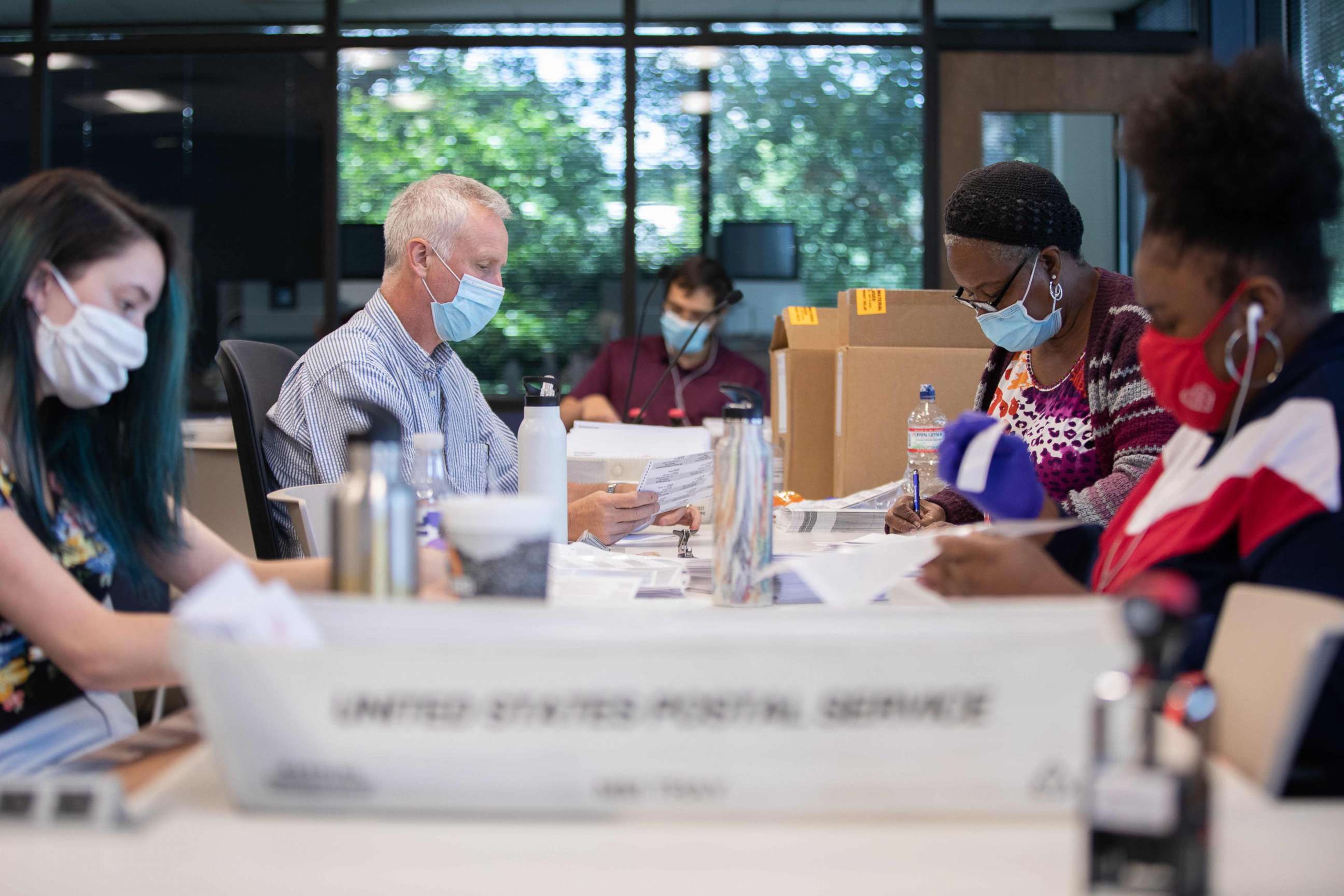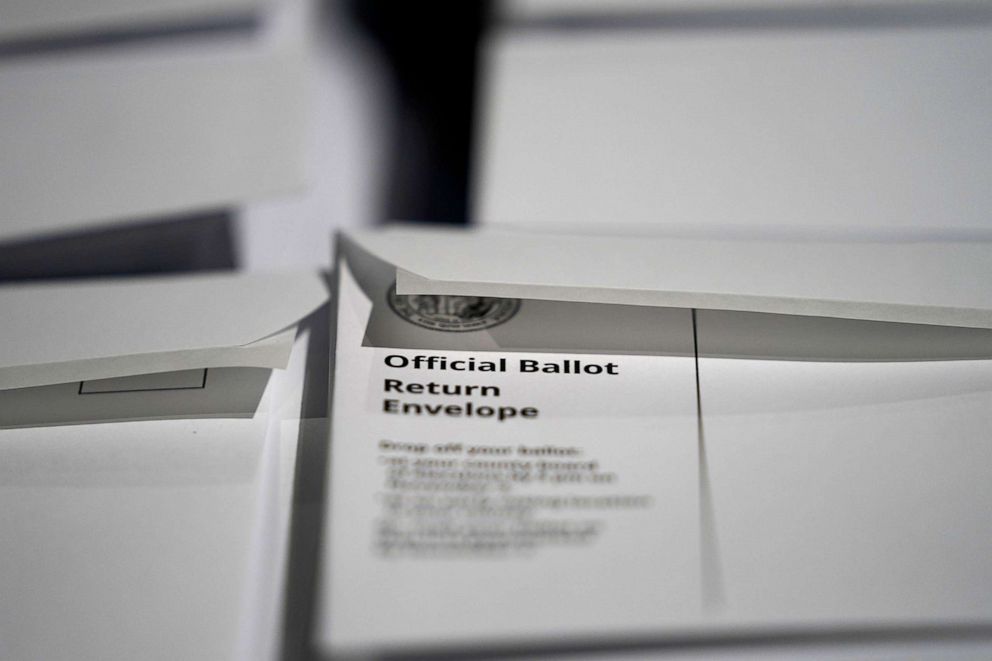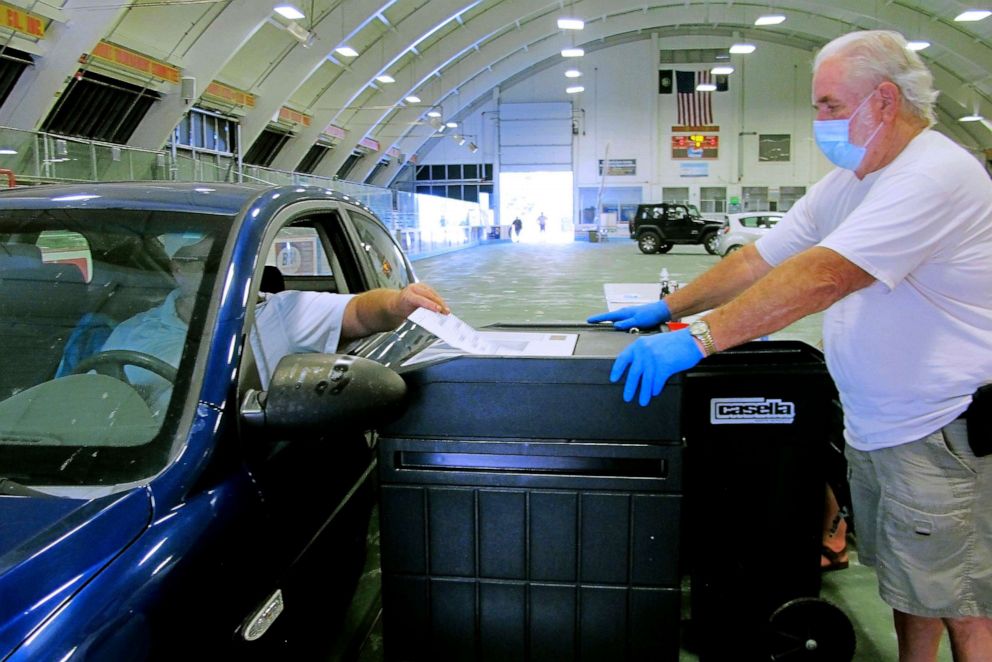Here's how states have changed the rules around voting amid the coronavirus pandemic
Nine states plus D.C. will send mail-in ballots to active registered voters.
Voting has always been cumbersome: Laws and deadlines vary state-by-state; key information can be difficult to nail down; and changes made to the process may go unnoticed by voters until it's time for them to engage in their civic duty.
But voting during a global pandemic? That's an entirely new beast that election officials and voters nationwide are now having to grapple with.
Beginning in March, the coronavirus outbreak upended the presidential and statewide primary calendar, leading many states to not only change the date of their elections, but also change how they conducted those elections.
Some states consolidated the number of in-person polling locations on election day -- often due to the difficulty of recruiting poll workers, who tend to be older Americans more susceptible to the most dire consequences of the virus. Other states conducted primarily all-mail elections. There were some that proactively sent applications to vote by mail to registered voters. And some states loosened restrictions around who qualified to cast an absentee mail ballot and what voters needed to provide in order to do so.
While the coronavirus is still impacting daily life all across the country, there's one very important thing that can't change for the general election: The date it's held.
Absent Congress passing a bill and the president signing that bill into law -- and there are no signs Congress is considering such a serious move -- the Election Day remains set for Nov. 3, the first Tuesday of the month.

But that doesn't mean states are powerless in making it easier for voters to participate in what both Democrats and Republicans are calling the most consequential election of our lifetime.
State and local election officials have been gearing up for a presidential election like no other before -- one voters should think about as an election season rather than just an Election Day.
With just six weeks until Nov. 3, here are the major ways voting by mail has been made more accessible for the upcoming election:
How have states expanded or relaxed the rules around mail-in voting amid the pandemic?
Voting advocates have touted mail-in voting as a safe and secure alternative to voting in person since the pandemic started. The statewide primaries that took place early in the pandemic served as trial runs for states from coast to coast.
For the general election, at least 30 states plus the District of Columbia have made at least some changes that will make it easier and more accessible for voters to cast their ballots from home. These changes include removing strict excuse requirements or allowing COVID-19 concerns to be a valid excuse to vote absentee, allowing ballot drop boxes, offering prepaid postage on election mail and proactively sending all active registered voters applications to request an absentee ballot -- with some even skipping that step and sending the actual ballots.
The states are: Alabama, Arkansas, California, Connecticut, Delaware, District of Columbia, Georgia, Illinois, Iowa, Kentucky, Maryland, Massachusetts, Michigan, Minnesota, Missouri, Montana, Nebraska, Nevada, New Hampshire, New Jersey, New York, North Carolina, Ohio, Oklahoma, Pennsylvania, Rhode Island, South Carolina, Texas, Vermont, West Virginia and Wisconsin.
Don't see the state you live in listed? That doesn't necessarily mean it will be hard for voters to cast mail-in ballots. Prior to the 2020 election cycle, some states -- like Arizona, Colorado, Florida and Washington -- already had robust or predominantly vote-by-mail elections, and voters were familiar with the system, so there hasn't necessarily been a need for them to change the rules.
A few states require voters to have a witness or notary signature in order for their returned absentee ballots to be counted -- a requirement that could be an issue for voters who live alone and are trying to keep their distance from others during this time. Both Rhode Island and North Carolina -- a battleground state -- typically require either two witnesses or one notary to sign voters' absentee ballots. Rhode Island has completely eliminated this requirement for November, and in North Carolina, only one witness is required instead of two. Minnesota eliminated the witness signature requirement for its primary, and this has been extended for the general election, too.
The witness requirement was waived for the primary in South Carolina, and a federal judge ruled on Friday that it will not be required for the general election either, citing how severe the pandemic is as the reasoning.
The states that are still requiring this are Oklahoma, Alaska and Alabama.

According to the National Conference of State Legislatures (NCSL), 17 states pay for postage on election mail, but for the November election, at least five more are doing this as well: Massachusetts, Montana, South Carolina and two battlegrounds -- Ohio and Pennsylvania.
There has also been growing concern over whether the United States Postal Service will be able to deliver mail-in ballots in a timely manner. In mid-August, ABC News reported that the Postal Service sent letters to 46 states and the District of Columbia saying that their absentee voting deadlines may be "incongruous" with the agency's delivery standards.
What's key to know about the laws in one's respective state is whether their mail-in ballots need to be received by the time polls close on Election Day or whether ballots only need to be postmarked on or before Election Day and received within a specified number of days after the election.
According to the NCSL, 18 states have postmark-by-date laws on the books, meaning that as long as ballots are postmarked on or before Election Day -- or in some cases by the day prior to the election -- they will be counted, as long as they make it to election officials by a specified deadline, ranging from three to 14 days after the election. Not all mail gets a postmark date on it, so be sure that your returned ballot has one.
Thanks to legal challenges from voting rights advocates, some states that typically require ballots to be received by polls closing time will accept ballots postmarked by Election Day for the 2020 election.
In the three "Blue Wall" states the president won in 2016 -- Michigan, Pennsylvania and Wisconsin -- judges have recently issued rulings that extend the deadline for mail ballots to be received.
In Michigan, a court of claims judge ordered clerks to accept ballots that are postmarked by Nov. 2 and received within 14 days of the election, the deadline for results to be certified. These ballots have to be counted as provisional ballots. In Wisconsin, a U.S. district judge ruled that ballots postmarked by Nov. 3 can be counted as long as they are received by Nov. 9. And in Pennsylvania, not only will mailed ballots that are postmarked on or before 8 p.m. on Election Day and received by 5 p.m. the Friday after it be counted, due to a ruling from the state Supreme Court, but any ballots that arrive within that time frame without a postmark, or with an unreadable postmark, will be presumed to have been sent before the cutoff point, unless evidence indicates otherwise.
In Minnesota, ballots postmarked by Election Day and received within a week after the election will be counted. Both Massachusetts and Kentucky are allowing postmarked ballots received by Nov. 6 to be counted. In New Jersey, ballots received by 8 p.m. on Nov. 10 will be counted if they are postmarked on or before Nov. 3, but additionally, ballots without a postmark due to a postal error will be counted as well if they are received by 8 p.m. on Nov. 5.
In Georgia, a federal judge ruled that ballots postmarked by Election Day will count if election officials get them by the third day after the election, but the secretary of state, the Republican National Committee and the Georgia Republican Party are challenging this order in court. The RNC and Georgia GOP are arguing the ruling only applies to 17 counties that were "cherry picked" to be advantageous to Democrats. The judge's order extending the deadline doesn't specifically state it applies statewide, but it does order that those under Raffensperger's "supervision, direction, or control shall accept and count otherwise valid absentee ballots from qualified voters" that meet the postmark requirement and arrive by Nov. 6.
Voters who don't trust the mail system do have another option. Typically, absentee ballots can be returned to local election offices, but in some states, there's another way to return mail ballots: secure drop boxes.
Eight states where a significant percentage of voters choose to cast ballots by mail always have ballot drop boxes, according to the NCSL: Arizona, California, Colorado, Hawaii, Montana, New Mexico, Oregon and Washington.
Because of the expected influx in voters casting their ballots by mail, several other states have decided to set up ballot drop boxes, including Georgia, Maryland and New Jersey.
Pennsylvania utilized drop boxes for its primary. While the Trump campaign sued to prevent counties from using them, alleging that the way counties implemented these -- bypassing the state legislature to do it -- was unconstitutional, the state Supreme Court ruled that these are legal, writing in the ruling that "Election Code should be interpreted to allow county boards of election to accept hand-delivered mail-in ballots at locations other than their office addresses including drop-boxes."

Can anyone vote by mail in my state?
In non-pandemic times, there are 16 states that have strict excuse requirements for who can vote absentee: Alabama, Arkansas, Connecticut, Delaware, Indiana, Kentucky, Louisiana, Massachusetts, Mississippi, Missouri, New Hampshire, New York, South Carolina, Tennessee, Texas and West Virginia.
Three of these states -- Massachusetts, Delaware and South Carolina -- have eliminated the excuse requirement altogether for the November election. Eight of these states -- Alabama, Arkansas, Connecticut, Kentucky, Missouri, New Hampshire, New York and West Virginia -- are allowing all voters to cite the coronavirus pandemic as a reason to cast their ballot by mail for the general election.
So there are now only five states that still require a reason beyond the coronavirus to vote absentee: Indiana, Louisiana, Mississippi, Tennessee and Texas.
During the primary, Tennessee had allowed anyone to cite the pandemic to vote absentee, but the state Supreme Court ruled on the eve of its Aug. 6 primary that fear of contracting COVID-19 will not be a valid excuse to vote-by-mail in the November general election.
While the court ordered that it will not require the state to allow for no-excuse absentee voting in the fall, it instructed state officials to ensure that voters who could be at risk of contracting the coronavirus -- like a voter with an underlying health condition -- or caretakers for a person who is vulnerable to the virus know they can cast their ballots by mail.
Which states are sending absentee ballot applications? What about ballots?
Five states were already slated to proactively send mail-in ballots to registered voters -- Hawaii, Colorado, Oregon, Utah and Washington. While it's Hawaii's first election cycle doing this, all five of these states have a predominantly vote-by-mail system.
In addition to those five states, California, Nevada, New Jersey, Vermont and the District of Columbia have decided to mail ballots to all active voters. In Montana, Democratic Gov. Steve Bullock is allowing any county to hold all-mail elections if they want to. All counties were given this option for the primary and did so, and 45 of the state's 56 counties, including the most populous, have opted to do this for the general election. Return ballot postage will be paid for. The counties doing this will mail ballots on Oct. 9 and in-person voting will still be available. In Nebraska, 11 counties will be proactively mailing ballots to voters, which is allowed under state law in any counties with less than 10,000 residents.
The Trump campaign lost its lawsuit in Nevada seeking to stop the state from mailing out ballots, among other pursuits. The campaign is also suing in New Jersey and Montana seeking to stop election officials from sending out ballots that haven't specifically been requested by voters. In New Jersey, the campaign has alleged that mass mailing of ballots is unconstitutional and in violation of federal statutes. In Montana, the campaign has alleged doing this will negatively affect the integrity of the election. The president has repeatedly claimed widespread mail-in voting will lead to fraud, but election experts dispute that.
Elections can be messy, but that doesn't mean they'll be fraudulent, ABC News chief legal analyst Dan Abrams noted on "This Week" in early August.
"Remember, when you're talking about universal mail-in ballots, let's be honest about what the issues are. Again and again you hear people say, 'Well, you know, they get sent to places where no one's there anymore, they've moved or they're not alive anymore.' And those are real issues," Abrams said. "But that's not voter fraud, right? Voter fraud then is the person who decides they're going to risk their freedom to take said ballot, falsify information, and then send it in."
In addition to the states sending ballots, others have opted to proactively send absentee ballot applications to voters. Nine states are currently planning to do this: Delaware, Illinois, Iowa, Ohio, Maryland, Massachusetts, Michigan, Rhode Island and Wisconsin.
Additionally, the rest of Nebraska's 93 counties that are not sending ballots will be sending applications to voters.
For its primary, Georgia's secretary of state opted to send all 6.9 million active voters in the state absentee ballot applications. While the state isn't doing the same for the general election, Secretary of State Brad Raffensperger did create an online absentee application portal that any voter statewide can use to request an absentee ballot.
Walter Jones, the communication manager for voter education in Raffensperger's office, told ABC News that some voters reported it taking less than a minute to fill out the application online. Upon completion of the application, voters receive an email, so they can be sure it was successfully submitted.
This story will continue to be updated as news warrants.




